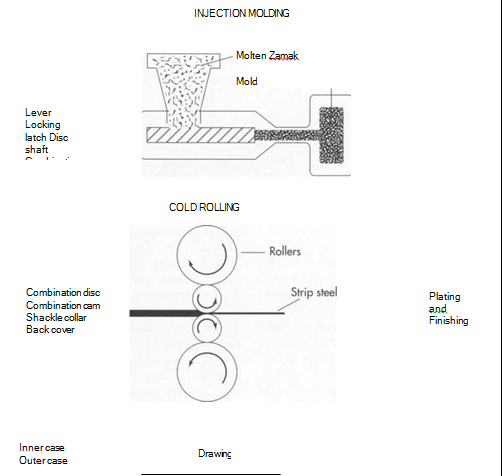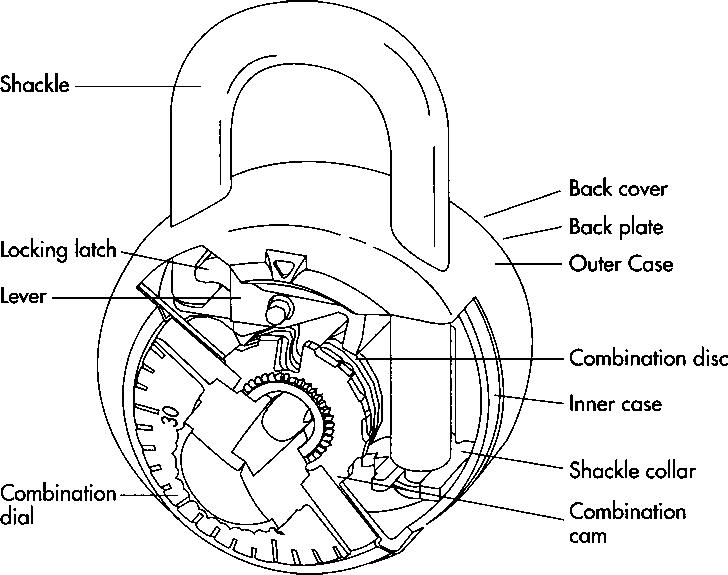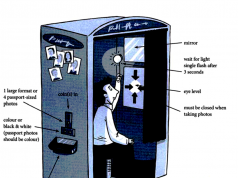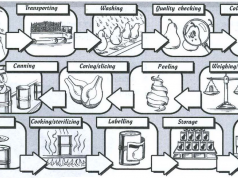
Background
The combination lock is one opened not by a key but by the alignment of its interior parts in a definite position. The most common types have an internal mechanism consisting of a series of three or four interconnected rings or discs that are attached to and turned by a central shaft. Manually rotating the outside knob or dial turns the discs, each of which is “programmed” to stop at a notched opening or gate. However, with a four-disc lock, certain preliminary spinning of the dial is necessary to get the lock to move the correct disc. The knob must first be turned to the right and spun past the first number four times before being allowed to stop beneath the marker. Next, rotating in the opposite direction, the knob must pass the second number three times. Reversing directions again, the user must spin the dial past the third number twice, and so on. When the apertures of all the rings align, they enable projections on a spring-loaded bolt to slide through, releasing the bolt and opening the lock.
Combination locks come in two varieties: hand and key change. One kind of hand combination lock that does not use internal wheels is the pushbutton lock, commonly installed in office doors and affording some measure of security. Pushing three or four buttons in order or together releases a shaft or deadbolt, allowing the door to open. The internal mechanism operates similarly to conventional padlocks.
Many people remember the simple padlocks that graced their school lockers. Picking these and other low-priced combination locks was frequently a game—and one often played successfully. With practice, an aspiring lock picker could actually hear the audible clicks made when the protuberances on the bolt aligned with the notches on the discs. However, manufacturers of better locks design false gates in the discs to make cracking the lock extremely difficult. Only experts can distinguish between the three or more false gates and the true gate, and, since a lock with four discs can use any of 100,000,000 possible combinations, identifying the correct one by chance is unlikely.
The combination lock was invented in China, although historical records provide little specific information about its development. Combination locks came into popular use in the United States in the mid-1800s to secure bank vaults. The locks, integrated into the vault doors, are a colorful footnote to the history of the old West as western films testify. In 1873 James Sargent foiled many a real bank robber by perfecting a time lock that, coupled with a combination lock, kept everyone out of the vault until the clock or clocks that regulated the lock reached the time at which it was set to open, usually once a day.
Raw Materials
A typical combination lock of the padlock variety has twenty component parts, generally made of stainless steel or cold-rolled steel that is plated or coated to resist corrosion. Combination locks are constructed to last a lifetime, and their parts are not intended to require repair or replacement. In addition to steel, two other raw materials are essential to the combination lock. Nylon is used for the spacers that separate the discs, enabling them to turn independently, while zamak, a zinc alloy, is molded under pressure to form the bar, shaft, and outside dial
(The various components in a combination lock are made in a variety of ways. Some components, such as those made from zamak, are injection molded—the zamak is heated to a molten state and forced into a mold of the desired shape. Other components, such as the combination cam and disc, are cold rolled—passed between heavy rollers. Still other components are drawn or machined to the proper shape. Most of the components are then plated and finished to protect against corrosion)
Design
A combination lock’s parts can be divided into two categories: internal and external components. Excepting the springs when extended, none of the internal parts exceed two inches (5.08 centimeters) in length. The internal works of the locking mechanism comprise the lever and supporting lever post and a disc shaft about which disc spacers and the combination disc turn. Two, three, or four combination discs are the key precision elements of the mechanism, but it is the combination cam, a notched disc, that generates the combination for the lock mechanism. The cam is also attached to the outside combination dial that is turned by the lock’s user. The internal disc spring supports the combination discs under tension, enabling the combination to be dialed. Other internal components in the lock case include a shackle collar that holds the shackle (the U- shaped component that detaches from the case when the lock has been opened) in the locked position with a latch that fits into the shackle notch. An inner case encloses all internal parts and gives the lock body housing strength. External parts include the lock’s outer case, the shackle, a back cover, and the combination dial.
The Manufacturing Process
The twenty component parts of the typical combination lock are formed, drawn, cut, pressed, and molded on a variety of machines, both manual and automatic.
Making the internal components
(A fully constructed combination lock. It is the combination cam, a notched disc, that generates the combination for the lock mechanism. Combination locks are built to last a lifetime, and their parts are not intended to require repair or replacement)
1 The lever, locking latch, and disc shaft are all made by injection molding, a process in which molten zamak is poured into a mold and subjected to heat and pressure until it solidifies into the shape of the mold. Although the post is shaped at room temperature, it is also formed under high pressure.
The combination disc and the cam are made of cold-rolled—passed under huge rolls without being heated—flat strip steel; after being cold rolled, the steel is put in a blanking die, a sophisticated cookie cutter, which cuts (or blanks) out the properly shaped piece. The internal disc spring is made from stainless steel round wire and produced on a spring winder that automatically twists and turns the wire to form the traditional coil spring. The shackle collar, like the combination disc and cam, is made from cold-rolled flat strip steel that is blanked in a blanking die. The inner case is produced from flat steel strip and drawn to a cup configuration. This process requires great pressure to stretch and compress the material as it is pressed or drawn around a die, whose shape it takes.
Making the outer parts
2 The outer case is manufactured similarly to the inner case but from stainless steel sheet instead of strip. The back cover, also stainless steel, is blanked in a blanking die. The durable shackle is made of round bar stock and machined on a screw machine, then formed to its U-shape and notched to accept the locking latch. It is finally annealed (heated to great temperature before being quenched in water) to make it resistant to hacksaws and bolt cutters. The combination dial, also zamak, is injection molded, then chromized. This process involves heating the part in a salt bath rich in chromium. The steel absorbs the chromium, which hardens on the surface as it cools rapidly. The dial is painted black and white wiped, which leaves the numbers highlighted against the black face.
Plating the components
3 Several plating and finishing processes can be used to protect the components against corrosion. The lever, disc shaft, combination cam, and dial are chromized. The inner case, shackle collar, and lever post are all cadmium-plated. The shackle and locking latch are copper nickel-plated. The outer case, of stainless steel, is mechanically polished to enhance luster.
Assembling the lock
4 Assembly of the components is precise with the back plate disc shaft, combination cam, and spacers forming one subassembly. The outer and inner cases are riveted together and then pierced at the point where the shackle is inserted. The combination dial, outer and inner case unit, and combination cam are then fastened together. Finally, these sub-assemblies and the remaining parts are fitted together. The lock case is closed and the edges folded over and sealed. Conventional hardware fasteners that can be released with the proper tool are not used.
Labeling and packaging
5 The remaining operation is the application of a removable tag or label to the lock. On this tag is the combination, determined randomly by machine draw. Lock manufacturers today jealously guard their combination setting procedures. A typical combination lock is sold in blister pack, a rigid molded plastic with cardboard backing, although locks may also be individually boxed.
Quality Control
Before any lock is packaged, many manufacturers completely test the locking and unlocking sequence. Other inspections and measurements are performed by individual operators at their stations during both manufacturing and assembly. Combination locks today enjoy a reputation for excellent reliability and durability.
Where To Learn More
Books
All About Locks and Locksmithing. Haw¬thorne Books, 1972.
Combination Lock Principles. Gordon Press Publishers, 1986.
The Complete Book of Locks and Lock- smithing. Tab Books, 1991.











